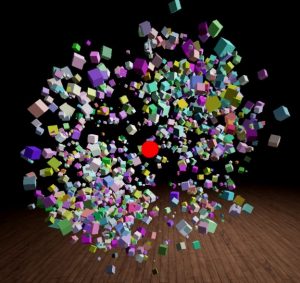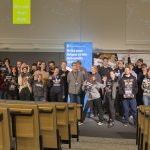As another academic year draws to an end, it’s high time to recap some of the hard work our people have been doing in the lab. From the computational neuroscience side of things, this spring we had a total of three students defending their thesis under our guidance. The extended team of students and supervisors for this year can be seen above. There’s a lot to cover, so let’s start with the least surprising topic:
As our neruscience-related research interests are focused around the theory of active inference, we wanted to improve on a previous experiment showing that attention is withdrawn from the area of the visual field where the own hand is currently moving. In the original work we had measured attention via reaction times, but we wanted a more direct way of probing the effects of active inference. Lucky for us, Tõnis Koppel (rightmost in the picture) joined the group and constructed a program to generate and show Gabor patches of various contrast behind the (invisible) hand of the study subject in VR. He also did some pilot tests and analysis to iron out any bugs and fine-tune the setup. Initial results are promising, but more work will follow this summer.
The next thesis tackles active inference from a more surprising angle. So much so that we even called the whole thing “Paralysed by surprise”. The main idea is simple – according to the active inference theory the brain must inhibit the sensory data coming from let say it’s own hand in order to move it. But this inhibition is not trivial and demands resources, especially when the environment is dynamic and hard to predict and generalize. So we had the pleasure of working with Taavi Gilden (second left on the picture) to create a VR application to generate either more or less salient stimuli to see whether we can tax the active inference system and make the subject react slower in conditions where the environment would be more difficult to inhibit. The program works like a charm but more data will give us a clearer answer to this question. A hint for why we called it the “disco boxes” experiment can be seen on the right, with one diagonal being more salient than the other.
The third thesis seems a bit of an odd-ball at first, fitting better in a carnival setting than in a science lab. By studying roll-axis vection in VR we wanted to make the subjects head spin and measure the ensuing effects objectively. Oh, sorry, stop, what’s vection? Vection is an illusion of self-motion! In a sense it was a rather “blue skies” research, meaning that we didn’t know what to expect. But we had Al William Tammsaar (bigger guy with the hat on the picture), who thought out some wild rotational models for the environments and then managed to measure the effect they had on behavior. As hoped, we managed to filter out some very interesting movement patterns that worked extremely well and some that surprisingly seemed to be rather mild, although by the standing literature they should have been as bad as the rest. Both models actually tie well into the predictive coding paradigm, so we will definitely continue work on this front to uncover the inner workings of the computations in the brain. While fine-tuning the experimental parameters we also shot a quick video to give an idea of what the procedure looked like. Watch the clip below, notice the monitor that shows the headset view and remember that the study subject was completely sober!
Congratulations again to all the students for defending their thesis works and a huge thanks for advancing computational neuroscience and virtual reality!
Kudos also to the computer graphics specialists in the lab who helped out with various issues during development of these projects.
Madis Vasser & Jaan Aru



